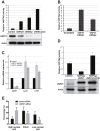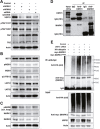USP21 regulates Hippo pathway activity by mediating MARK protein turnover
- PMID: 28969054
- PMCID: PMC5609986
- DOI: 10.18632/oncotarget.19322
USP21 regulates Hippo pathway activity by mediating MARK protein turnover
Abstract
The Hippo pathway, which acts to repress the activity of YAP and TAZ trancriptional co-activators, serve as a barrier for oncogenic transformation. Unlike other oncoproteins, YAP and TAZ are rarely activated by mutations or amplified in cancer. However, elevated YAP/TAZ activity is frequently observed in cancer and often correlates with worse survival. The activity and stability of Hippo pathway components, including YAP/TAZ, AMOT and LATS1/2, are regulated by ubiquitin-mediated protein degradation. Aberrant expression of ubiquitin ligase complexes that regulate the turnover of Hippo components and deubiquitylating enzymes that counteract these ubiquitin ligases have been implicated in human cancer. Here we identify the USP21 deubiquitylating enzyme as a novel regulator of Hippo pathway activity. We provide evidence that USP21 regulates YAP/TAZ activity by controlling the stability of MARK kinases, which promote Hippo signaling. Low expression of USP21 in early stage renal clear cell carcinoma suggests that USP21 may be a useful biomarker.
Keywords: Hippo pathway; LATS; MARK; YAP; ubiquitin.
Conflict of interest statement
CONFLICTS OF INTEREST The authors declare no conflicts of interest.
Figures




References
-
- Nguyen HT, Hong X, Tan S, Chen Q, Chan L, Fivaz M, Cohen SM, Voorhoeve PM. Viral small T oncoproteins transform cells by alleviating hippo-pathway-mediated inhibition of the YAP proto-oncogene. Cell Rep. 2014;8:707–713. - PubMed
-
- Harvey KF, Zhang X, Thomas DM. The Hippo pathway and human cancer. Nat Rev Cancer. 2013;13:246–257. - PubMed
-
- Richter AM, Pfeifer GP, Dammann RH. The RASSF proteins in cancer; from epigenetic silencing to functional characterization. Biochim Biophys Acta. 2009;1796:114–128. - PubMed
LinkOut - more resources
Full Text Sources
Other Literature Sources
Molecular Biology Databases
Research Materials

